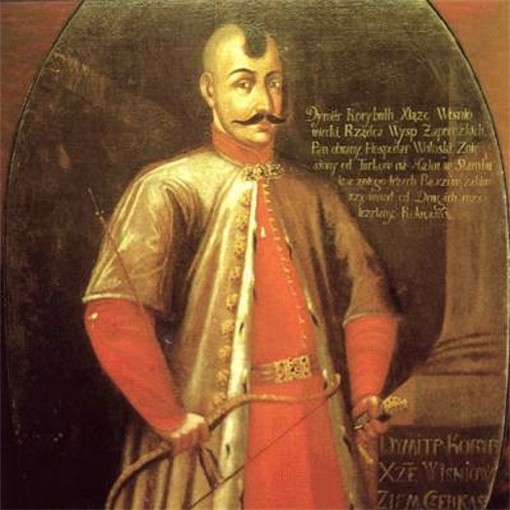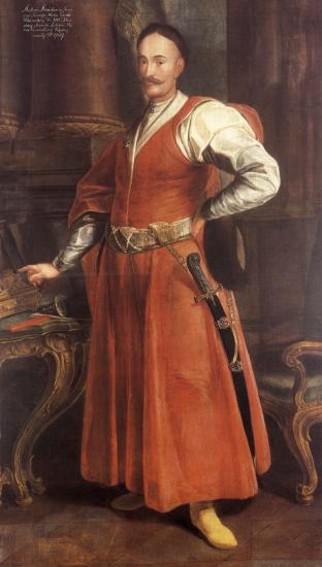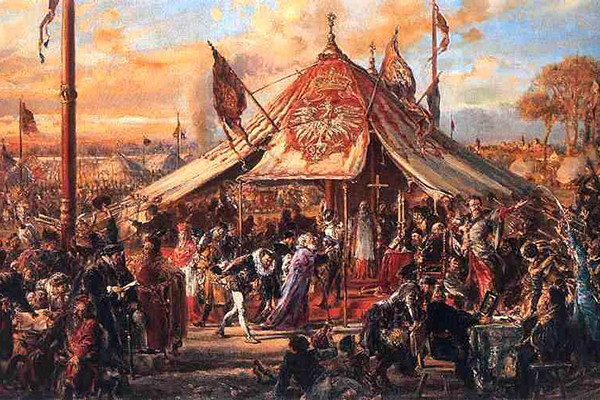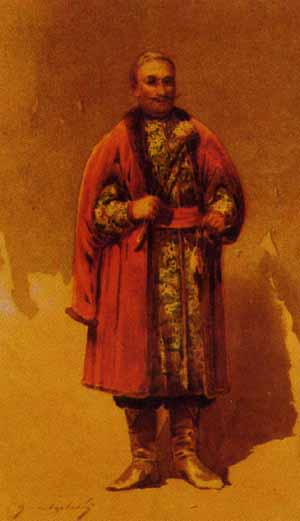Nobility
Nobility (шляхта; shliakhta; Polish: szlachta; derived from Old German Slahta, ‘gender’). The privileged and titled elite class of society. The concept of a noble class (or aristocracy) is largely a European one that developed out of the feudal experience. In Eastern Europe the nobility as a social elite with inherent rights established itself most strongly in the Polish-Lithuanian Commonwealth. In Muscovy and then the Russian Empire the status of the nobility was more closely tied to state service. In Ukraine, after the Princely era, the existence of a distinctive elite class of native nobles was largely pre-empted by the country's domination first by Poland and then by the Russian Empire (which prompted the considerable assimilation of Ukraine's upper class by foreign aristocracies). The notable exceptions to that long-standing state of affairs could be found in the Lithuanian-Ruthenian state, where Orthodox Ukrainian nobles constituted a distinctive subgroup of the aristocracy, and in the Hetman state, where the Cossack starshyna was developing into a noble class. As a result of the assimilation, the social structure of Ukraine was truncated for many years, and Ukrainian society was left without a leading element. Nevertheless, individual noblemen emerged at various times as key figures in the defence of Ukrainian social, religious, and political rights.
Polish and Lithuanian rule. The nobility in the Ukrainian and Belarusian territories originated with knights who established themselves as a class (nobilis) first through military service (jus militare) and then heredity (jus hereditarium). Initially that nobility had a lesser stature than magnates and lords and (in Ukrainian territories) the prince and boyars. The members of the nobility were obliged to perform military service, for which they were accorded various privileges, including exemption from taxation and autonomy from local authorities. It was not a closed caste, and it took in new members from the peasantry and clergy.
The nobility steadily expanded its influence in state affairs, by using changing political and social circumstances to its advantage. Polish kings sought its assistance in their own struggle to establish a centralized state in opposition to the atomizing influence of the great landowners. In return the nobility was rewarded with a host of further privileges. King Louis of Anjou conferred the Košice privilege (1374) on those who served in his armies. It exempted noblemen from all duties other than the land tax of two Groschen per field (lan), extended immunity from arbitrary seizure of property and person, limited the terms of military service, and offered the right to state offices, such as voivode, castellan, justice, and chamberlain. The privilege proved a critical development in the transformation of the nobility from a warrior brotherhood into a social and economic class, consisting of lords and barons, knights (rycerzy, milites), and middle and small landowners, who set themselves apart from the rest of the population by their claim to a coat of arms. In time the nobility came to command considerable influence in parliamentary bodies. It extended its powers with the Cracow privilege (1433) and the Cerekwica privilege, which was later confirmed by the Nieszawa statute (1454). By then the nobility had gained legislative powers in matters of war and peace and exemption from the royal court. The Nieszawa statute also struck down the exclusive right of magnates to hold higher governmental positions and limited the rights of towns. King Jan I Olbracht's Piotrków statute (1496) bound the peasantry to the land and exempted the nobility from paying duties on imported goods.
Galician boyars were granted equal status with the Polish nobility in 1430. Subsequently some of them were Polonized, and others moved to Volhynia and Podilia. By the 16th century there were no Ukrainian boyar families left in Galicia; only some petty gentry regarded themselves as Ukrainians.
Through the 16th to 18th centuries the nobility progressively increased its influence in the Polish-Lithuanian Commonwealth, although its constitutional battles weakened the state. The szlachta disregarded that weakening in the defense of what it regarded as its ‘golden freedoms.’ It developed a corporate sense as the ‘szlachta nation.’ It also established an ideology of sorts for itself, based on the belief that the szlachta had descended from the ancient Sarmatians and was imbued with a purity of purpose that had been lost by the nobility of other European nations. In 1573 (under Henry III of Valois) the nobles obtained the right to the election of the king by direct vote. That right effectively transformed the Polish state into an aristocratic republic and made the regal position an increasingly ineffectual one. The parliamentary body, the Sejm, was also rendered largely ineffectual after the invocation (from 1652) of the liberum veto, which allowed for the passage of legislation only by the complete unanimity of all of its delegates (a single veto could stop deliberations altogether). The resulting chaos initiated Poland's decline until its partition by other European powers in the late 18th century.
The nobility in Ukrainian territories in the Grand Duchy of Lithuania led a separate existence from that in Poland, but it was nevertheless influenced by sociopolitical developments there. A Polish-style aristocratic order was introduced by Polish kings or grand dukes through similar privileges or legal codes. Lithuania, however, contained two strata of nobility: the Lithuanian, which had rapidly been Catholicized, and the Belarusian-Ukrainian, which remained Orthodox. Both Polish and Lithuanian rulers tended to favor the Lithuanian nobility and usually granted privileges to Belarusian and Ukrainian nobles only when their assistance was required or a rebellion was threatening. The titles used in those areas, such as prince and boyar, were carried over from Kyivan Rus’, although others (used mainly by Poles) were added, including barones, nobiles, ziemianie, and szlachta.
After the Union of Krevo in 1385, Grand Duke Jagiełło converted to Catholicism. In 1387 he officially made his realm Catholic and conferred privileges on those boyars who adopted that faith. The Union of Horodlo between Poland and Lithuania in 1413 granted the Lithuanian Catholic boyars equal rights with their Polish counterparts and transformed them into a hereditary elite. At the same time it relegated the Orthodox (including Ukrainian) nobility to secondary status. Only in 1432, after civil strife between religious factions, were the rights of the Orthodox and Catholic nobility placed on an equal footing. That equality was legally affirmed in 1447 (principibus et boiaris tam Lithuanis quam Ruthenis). The rights of the Lithuanian-Ruthenian nobility were supplemented and expanded in 1492 and 1506. In 1501 and 1509, local privileges were conferred on the Volhynian nobility. Among that group were notable noble families, including the Ostrozky, Sanguszko, Czartoryski, and Zbaraski, who possessed massive estates. Until the late 16th century the majority of the Volhynian magnates were Ukrainian; they were largely Polonized in the 17th and 18th centuries.
The rights and privileges of the nobility were codified in the Lithuanian Statute and confirmed by its three editions. In 1529 the conditions for acceptance into the aristocracy (which favored magnates) were outlined; in 1566 the rights of the regular nobility were expanded, and their representatives were accepted into parliament; in 1588 the rights of the nobility were entrenched, and the peasantry was enserfed (see Serfdom). The last edition of the statute underscored that the nobles' claims to estates were based not on the fact of settlement but on notable military service against the enemy.
The Union of Lublin in 1569 brought Volhynia, Podlachia, the Kyiv region, and the Bratslav region under direct Polish control. At the same time the rights of the local nobility were brought into line with those of Poland. The newly acquired territories soon saw an influx of Polish magnates, including the Żółkiewski, Potocki, Koniecpolski, and Kalinowski families. It also set in motion a long process of Polonization that became a feature of Right-Bank Ukraine: by the early 19th century little non-Polonized Ukrainian nobility remained.
Polonization began after the Union of Lublin and was particularly enforced under Jan II Casimir Vasa, who in 1649 forbade non-Catholic representation in the Senate and starosta councils. In 1712 the Polish parliament outlawed the non-Catholic nobility altogether. Nevertheless there were Ukrainian nobles who continued to adhere to Orthodoxy, as borne out by the provisions of a treaty signed by Russia and Poland in 1775 that guaranteed to Orthodox nobles the same rights as Catholics. In Right-Bank Ukraine (Volhynia, Podilia, the Kyiv region) Polonization of the Ukrainian gentry continued even after the partitions of Poland. After the Polish Insurrection of 1830–1, however, the tsarist authorities actively began trying to counter Polish influence in the region by Russifying its institutions and inhabitants. According to a study of the Right-Bank nobility undertaken by the Kyiv Archeographic Commission only one-tenth of the Right-Bank nobility of the 1860s was of Polish origin. The rest consisted almost entirely of Ukrainian converts to Catholicism. The commission uncovered 711 Ukrainian noble family lines and supplied exact dates of conversion for 140 cases (1 before 1569, 10 in 1569–1600, 48 in 1600–50, 40 in 1650–1700, and 41 in 1700–67).
Galician families that maintained their Ukrainian identity included the Balaban, Cholhansky, Demydetsky, Drahomyretsky, Hoshovsky, Kulchytsky, and Yavorsky lines. In the early 17th century there were 628 Ukrainian noblemen in the Lviv region and 1,000 in the Peremyshl region. Most of them were so impoverished that they did not have their own horses when they came to serve in the army. In the Kholm region, Podilia, and Podlachia Polonization had set in during the 15th century, and it continued until the 19th century. The Ukrainian aristocracy of the Kyiv region and Bratslav region was subject to a general process of Polonization.
After 1569 the significance of the nobility as a Ukrainian social elite diminished. Nevertheless it continued to play a role in judicial affairs (notably with the Lutsk Tribunal) and in the defense of the Orthodox church. Ukrainian nobles spoke out for the Orthodox church in legislative councils and influenced the selection of the bishop of Lviv (5 April 1641) and of Sylvestr Kosiv as metropolitan of Kyiv (25 February 1647). Among the defenders of the Ukrainian Orthodox church were Lavrentii Drevynsky, M. Kropyvnytsky, and Adam Kysil; those who were otherwise active in cultural and church affairs included the Balaban line, Atanasii Kalnofoisky, Mykhail Kopystensky and Zakhariia Kopystensky, and Yelysei Pletenetsky.
The Cossack era. Ukrainian noblemen played a significant role in the emergence of the Cossack state. They were commonly found in the higher ranks of the registered Cossacks, and later provided the impetus and direction required to transform the Cossacks from an amorphous social class into the creators and administrators of a new polity, the Hetman state. Some notable Cossack leaders drawn from the nobility were Prince Dmytro Vyshnevetsky, Kryshtof Kosynsky, Mykhailo Khmelnytsky, Petro Konashevych-Sahaidachny, and Bohdan Khmelnytsky.
The profound changes effected in Ukraine by the Cossacks and the Bohdan Khmelnytsky uprising in 1648 did not include the elimination of a landed social elite. In fact one of the key changes consisted of the replacement of the largely foreign szlachta with an indigenous ruling class, the Cossack starshyna. A portion of the nobility in Ukraine, although largely Polonized, supported Kmelnytsky's revolution and tied itself to the process of establishing a Cossack state. In the early stages of the Cossack-Polish War the aristocracy, both Ukrainian and non-Ukrainian, was forced off its lands in numerous local uprisings. But Khmelnytsky established instructions through universals for the restoration of property rights for those supporting the new order, namely ‘noblemen who will eat bread with us ... and recognize the authority of the Zaporozhian Host’ (1649). The pro-Cossack nobility, which had had experience in matters of state under the Polish regime, now served the new Hetman state apparatus in the diplomatic corps, military posts, and administrative and judicial offices. The leaders of Khmelnytsky's state drawn from the nobility included Hryhorii Hulianytsky, Mykhailo Krychevsky, Stanyslav Morozenko, Danylo Nechai, Ivan Vyhovsky, and Antin Zhdanovych. The Cossack register, drawn up after the Treaty of Zboriv in 1649, included 750 aristocratic families and more than 1,500 individuals. Other accounts (Viacheslav Lypynsky, Antoni Józef Rolle) estimate the number at 2,500, and the figure for nobles active in the Cossack army at between 6,000 and 7,000.
With the establishment of the Hetman state in Left-Bank Ukraine and the return to relative peace and order in the wake of the Ruin, the Cossack starshyna emerged as a social elite that fulfilled many of the roles of a nobility. It was composed largely of members of old, registered Cossack families, but also incorporated Orthodox landowners who supported the Hetman state as well as common Cossacks who had risen through the ranks. During the reigns of Hetmans Ivan Samoilovych (1672–87) and Ivan Mazepa (1687–1709) the starshyna began developing the attributes of a noble class. It managed to circumvent the Cossack principle of election to all offices by gradually turning the voting procedure into a pro-forma affair; although the members of the starshyna did not establish hereditary rights, they monopolized the offices of the Hetman state. They also made room for a second tier of starshyna by establishing categories within a society of notable military fellows (fellows of the standard, military fellows, and fellows of the banner) that were tied to no specific military or administrative posts. With position also came privileges, and the members of the starshyna were able to demand services from the peasantry by virtue of their office. The higher starshyna also established the right to be tried by its peers, another common trait of nobility. Finally the starshyna collectively expanded its landholdings through land grants, purchase, and, occasionally, simple seizure.
In the 18th century, while the Cossack starshyna established itself as a gentry elite in Left-Bank Ukraine, Right-Bank Ukraine saw the restoration of a Polish or Polonized nobility to a position of pre-eminence. At the same time, however, resentment against the nobility and landowners (often one and the same) in the region grew and gave rise to a series of haidamaka uprisings.
As the status of the starshyna became entrenched, its aspiration to continue in the tradition of the szlachta grew. That aspiration was increased in 1743, when a legal compendium entitled Prava, po kotorym suditsia malorossiiskii narod (The Laws by Which the Little Russian People Are Judged) established that descendants of appointed or hereditary nobles registered under the former state were entitled to nobility within the Russian Empire. It was further augmented in 1763, when the pidkomorskyi court was reintroduced. That year a major gathering of starshyna representatives met at the hetman's residence in Hlukhiv and proposed, among other things, the transformation of the Cossack officers' council into a diet of the nobility. The most articulate argument for the establishment of starshyna rule in Ukraine as a type of szlachta democracy was made in 1767 by Hryhorii A. Poletyka at Catherine II's Legislative Council.
Russian rule. In spite of the fact that Russia and then the Russian Empire had continually expanded its influence over the administration of Ukraine, the starshyna and regimental structure of the Hetman state had been left intact. That state of affairs changed quickly and completely under Catherine II. She abolished the office of the hetman (1764), had the Zaporozhian Sich destroyed (1775), and dismantled the regimental system in favor of provincial administration (1782). Notwithstanding the fact that its autonomy and territorial base had been taken away, the Ukrainian elite did not protest the changes. Instead it moved quickly to adapt itself to the new circumstances. The smoothness of the transition was aided by several factors. The governor-general of Ukraine, Petr Rumiantsev, had made specific efforts to prevent overt dissent from manifesting itself and had opened numerous governmental positions to noblemen or their sons in Ukraine. The institution of provincial administration was followed in 1783 by a ukase that established the complete serfdom of the Ukrainian peasantry. Finally Catherine II proclaimed a new Charter of the Nobility in 1785 that allowed for the incorporation of the Cossack starshyna into the Russian nobility. The starshyna had long sought legal recognition of its social status but had been hesitant to incorporate itself with the less privileged Russian nobility. The 1785 charter brought the privileges of Russian nobles (dvorianstvo) much in line with those of the szlachta. A wholesale quest for patents of nobility, sometimes with the aid of fabricated documentation, followed.
The starshyna gentry generally benefitted materially from its integration into the dvorianstvo system, particularly the petty gentry, which found considerable opportunity for advancement in the imperial service. At the same time Ukrainians experienced some unique problems in defining themselves within the broader context of the Russian Empire. Some chose total assimilation to the implicitly Russian culture and language. In its extreme form that response took the form of oversubscribing to the values of the dominant culture, in effect becoming ‘more Russian than the Russians’ and sometimes developing an outright disdain for Ukrainian traditions. Less dramatically, some developed a sense that Ukraine was in fact culturally inferior to Russia, the so-called Little Russian mentality, which implied deference to Great Russians. A more common response was a desire to integrate into the imperial system but to maintain certain institutional vestiges of the Hetman state. That response was a sentiment rather than a structured movement, and it focused on matters such as Ukraine's distinct legal code and a desire to have separate Ukrainian Cossack military formations. The nobility's reverence for Ukraine's Cossack heritage was challenged by the difficulties many experienced in obtaining their patents, in that the imperial Heraldic Office commonly questioned the validity of Ukrainian titles. The result was protests from the former starshyna gentry and a wide search for documents related to Ukraine's past, which ultimately served only to reinforce a sense of local patriotism.
In Right-Bank Ukraine, acquired by the Russian Empire through the partitioning of Poland, the rights of the local gentry were made equal with those of its Russian counterparts, although its szlachta privileges were limited. Initially the nobility retained its social status as a ruling class and contributed significantly to culture and education (eg, by establishing the Kremenets Lyceum). The Polish nobility consisted of a small number of magnates, independent landowners, and impoverished lesser aristocrats who were commonly employed as administrators or stewards on larger estates. In general the magnates integrated themselves quickly into the dvorianstvo system and were loyal to the empire, whereas the lesser nobility maintained a sense of Polish patriotism and hoped to restore Poland to its status before the partitions.
After the Polish Insurrection of 1830–1 Russian policy toward the nobility changed significantly. Nearly 10,000 participants in the revolt were prosecuted and had their holdings confiscated. A campaign was begun to verify aristocratic status, aimed at destroying the szlachta nobility as a foreign element within the Russian system. Lasting approx 20 years under the direction of the governor-general, Dimitrii Bibikov, the action stripped 340,000 individuals of their status as nobles: 72,000 in 1832–3, 93,000 in 1834–9, 160,000 in 1840–6, and 15,000 in 1846–53. The lesser, poor, and generally, landless nobility suffered. After the verification some 70,000 Poles (nearly 17,500 families) entrenched their claims to nobility. They were primarily large to middle landowners (szlachta ziemiańska), who controlled nearly three million serfs. The majority of the legally recognized nobility supported the Russian government, forsook its persecuted countrymen, and was indifferent to all revolutionary movements. Later it sought to integrate itself into Russian society. After the Polish Insurrection of 1863–4, in which a section of the nobility once again took part, further limitations on noble participation in political, community, and cultural life were imposed.
In spite of the Polish domination of the Right-Bank nobility several pro-Ukrainian movements developed. The khlopoman movement emerged in the late 1850s, and a Ukrainophile movement headed by Viacheslav Lypynsky emerged among the Polonized Ukrainian gentry at the end of the 19th century. But the position of the nobility in Right-Bank Ukraine did not change until after the Revolution of 1917. At that time Polish efforts to guarantee special rights for Polish landowners in Ukraine resulted in special provisions in the Treaty of Warsaw. Those provisions, however, were abrogated with the establishment of Soviet power in Ukraine and the end of the nobility as a class.
Western Ukraine. In Ukrainian territories under the Austrian Empire the nobility on Ukrainian territory enjoyed the same rights as its counterparts elsewhere in Austria. Initially, Joseph II's reforms limited the rights of the Polish aristocracy. After his death in 1790, however, the nobility gradually came to control large sectors of the empire's administrative structure and was able to influence highly placed Austrian officials. The Polish nobility's influence increased even more during the tenure of the Galician vicegerent, Agenor Gołuchowski (1849–75, with interruptions). In the interwar Polish state (with Ukrainian territories in its eastern reaches) the nobility as a social class was legislated out of existence (1921). Nevertheless the landed aristocracy maintained its extensive political and economic influence.
In Bukovyna the Ukrainian nobility over time assimilated with the Moldavian-Romanian elite of the region. Under Austria (from 1774) the administrative structure was controlled by Romanian boyars, who later complained about Bukovyna's reconstitution into an administrative unit of Galicia (1787–1849). A government decree of 14 March 1787 gave the Bukovynian and Galician nobilities equal status. Even after the establishment of a constitutional monarchy in 1848, the Romanian nobility continued to have great influence in Bukovyna as a result of the curial electoral system.
A feudal order started developing in Transcarpathia in the wake of the Mongol invasion of 1241 and the establishment of a network of stone fortresses. Most of the nobility in the region consisted of Hungarians. Prince Fedir Koriiatovych, a late 14th- to early 15th-century ruler of the Mukachevo region, was the most notable Ukrainian (or Ukrainianized) nobleman in the area. From the 16th century the aristocracy of Transcarpathia was largely without Ukrainians.
BIBLIOGRAPHY
‘Akty o proiskhozhdenii shliakhetskikh rodov v Iugo-Zapadnoi Rossii,’ Arkhiv Iugo-Zapadnoi Rossii no. 4, vol 1 (Kyiv 1867)
Antonovich, V. Ob okolichnoi shliakhte (Kyiv 1867)
Romanovich-Slavatinskii, A. Dvorianstvo v Rossii ot nachala XVIII veka do otmeny krepostnogo prava (Saint Petersburg 1870; 2nd edn, Kyiv 1912)
Lipiński, W. Szlachta na Ukrainie: Udział jej w życiu narodu ukraińskiego na tle jego dziejów (Cracow 1909)
Hruszewski, M. Szlachta ukraińska na przełomie XVI i XVII wieku (Kyiv–Cracow 1912)
Lipiński, W. (ed). Z dziejów Ukrainy (Kyiv–Cracow 1912)
Okinshevych, L. ‘Znachne viis’kove tovarystvo v Ukraïni-Het’manshchyni XVII–XVIII st,’ ZNTSh, 157 (Munich 1948)
Backus, O. Motives of West Russian Nobles in Deserting Lithuania for Moscow, 1377–1514 (Lawrence, Kans 1957)
Grodziski, S. Obywatelstwo w szlacheckiej Rzeczypospolitej (Cracow 1963)
Maciszewski, J. Szlachta polska i jej państwo (Warsaw 1969)
Kohut, Z. ‘Problems in Studying the Post-Khmelnytsky Ukrainian Elite (1650s to 1830s),’ in Rethinking Ukrainian History, ed I. L. Rudnytsky (Edmonton 1981)
Sysyn, F. ‘The Problem of Nobilities in the Ukrainian Past: The Polish Period, 1569–1648,’ in Rethinking Ukrainian History, ed I. L. Rudnytsky (Edmonton 1981)
Kamiński, A. ‘The Szlachta of the Polish-Lithuanian Commonwealth and Their Government,’ in The Nobility in Russian and Eastern Europe, ed I. Banac and P. Bushkovitch (New Haven 1983)
Kohut, Z. ‘The Ukrainian Elite in the Eighteenth Century and Its Integration into the Russian Nobility,’ in The Nobility in Russian and Eastern Europe, ed I. Banac and P. Bushkovitch (New Haven 1983)
Beauvois, A. Le Noble, le serf, et le révizor: La noblesse polonaise entre le tsarisme et les masses ukrainiennes (1831–1863) (Paris 1986)
Subtelny, O. Domination of Eastern Europe: Native Nobilities and Foreign Absolutism, 1500–1715 (Kingston, Ont–Montreal 1986)
Rosman, M. The Lord's Jews: Magnate-Jewish Relations in the Polish-Lithuanian Commonwealth (Cambridge, Mass 1990)
LeDonne, J. Absolutism and Ruling Class: The Formation of the Russian Political Order, 1700–1825 (New York–Oxford 1991)
Šlusarek, K. ‘Szlachta w Galicji Wschodniej na przełomie XVIII i XIX wieku: Rozmieszczenie terytorialne i liczebność,’ Studia Historyczne, 34, no. 2 (1991)
Iakovenko, N. Ukraïns’ka shliakhta z kintsia XIV do seredyny XVII st. (Volyn’ i Tsentral’na Ukraïna (Kyiv 1993)
Arkadii Zhukovsky
[This article originally appeared in the Encyclopedia of Ukraine, vol. 3 (1993).]




.jpg)
